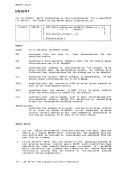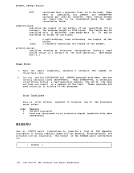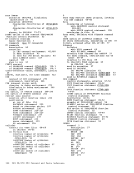LINEDIT Macro LINEDI! TEXT='HI!',DOT=NO the line is displayed as:
HI!Use the COMP operand when you want to display multiple blanks within your message text. The format of the COMP operand is:
For example, ifyou code:
LINEDITTEXT='TOTAL 5' ,COMP=NO the line is displayed as: TO!'AL 5. Use the SUB operand to specify the type of substitution to be performed
on those portions of the message that contain periods. For each set of
periods, you must specify the type of sUbstitution and the value to be
substituted or its address. The format of thesnB operand is: r -, I SUB= (
(HEX {' (reg) }
) ), , DEC ,expression 1 I 1 I HEXA{,addreSS} , , DECA , (reg) I I , I HEX4A f address } , I CHARA , (reg) , I CHAR8A , ({addreSS}, {length}) , t (reg) (reg) , L -3 Each of the possible sUbstitution pairs is described below, followed by
discussions of length specification and multiple substitution lists.HEX, (reg-) converts the value in the specified register to graphic hexadecimal
format and sUbstitutes it in the message text. If you code fewer
than eight consecutive periods in the message text, then leadingdiqits are truncated; leading zeros are not suppressed. For example, if register 3 contains the value C0031FC8, then the ma=ro instruction:
LINEDITTEXT='VALUE = ••• ',SUB=(HEX,(3)} results in the display: VALfJE = FCB.
322IB' VM/370 eMS Command and Macro Reference
HI!
For example, if
LINEDIT
on those portions of the message that contain periods. For each set of
periods, you must specify the type of sUbstitution and the value to be
substituted or its address. The format of the
(
) )
discussions of length specification and multiple substitution lists.
format and sUbstitutes it in the message text. If you code fewer
than eight consecutive periods in the message text, then leading
LINEDIT
322






















































































































































































































































































































































































































